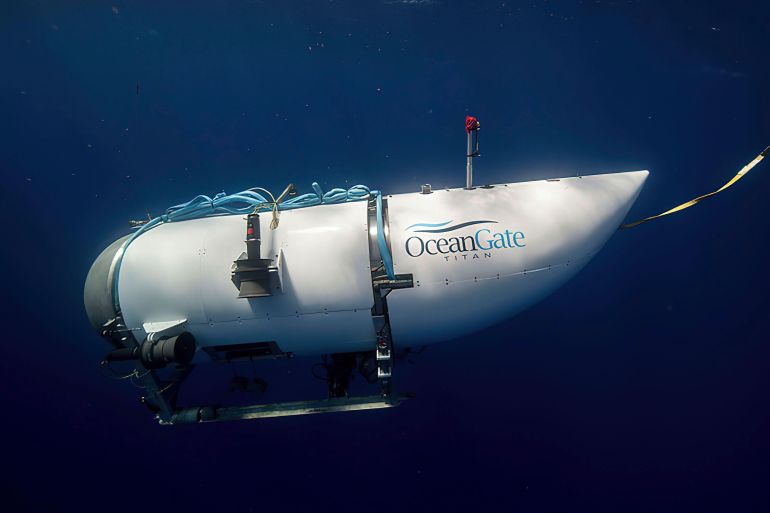Canadian, US safety regulators to probe fatal loss of Titan sub
Safety investigation likely to be complicated by poor regulation of deep-sea exploration.

Canadian and United States government authorities are starting a safety investigation following the undersea implosion of the Titan submersible that killed five people during a tourist expedition to the wreck of the Titanic in the North Atlantic.
A debris field from the lost submersible was found on Thursday by a robotic diving vehicle deployed from a Canadian search vessel, ending an intense five-day effort to locate the sub which went missing on Sunday after one hour and 45 minutes into a two-hour descent to reach the Titanic’s resting place.
Keep reading
list of 4 itemsWhat is a catastrophic implosion? All about the Titanic sub
‘Fake’ video of Ukrainians criticising Titan crew debunked
Titanic sub implosion: Was the deep ocean vehicle safe?
Fragments of Titan were discovered on the seabed about 488 metres (1,600 feet) from the bow of the Titanic wreck, about 4 kilometres (2.5 miles) below the surface, US Coast Guard Rear Admiral John Mauger said.
Mauger told reporters that the debris was consistent with “a catastrophic implosion of the vehicle”, meaning the vessel ultimately collapsed and was crushed under the immense hydrostatic pressure at that depth in the ocean.
In a statement on Friday, Canada’s Transportation Safety Board said it was launching a “safety investigation regarding the circumstances of this operation” because Titan’s surface support vessel, the Polar Prince, was a Canadian-flagged ship.
The US National Transportation Safety Board (NTSB) said on Friday that the US Coast Guard has declared the loss of the Titan submersible to be a “major marine casualty” and the coastguard will lead the investigation.
NTSB spokesperson Peter Knudson said that information was provided to the agency’s senior management by coastguard officials, and the NTSB has joined the investigation.
The coastguard has not confirmed that it will take the lead. Coastguard headquarters said the US Coast Guard First District in Boston will discuss future operations and plans, but did not say when.
It was not entirely clear on Friday who would lead the overall investigation which is sure to be a complex process involving several countries.
OceanGate Expeditions, the company that owned and operated the Titan, is based in the US but the submersible was registered in the Bahamas.
OceanGate is based in Everett, Washington, but closed when the Titan was found on Thursday. The Titan’s support ship, the Polar Prince, was from Canada, and those killed were from England, Pakistan, France, and the US.
How the overall investigation will proceed will also be complicated by the fact that the world of deep-sea exploration is not well-regulated.
Deep-sea expeditions like those offered by OceanGate are scrutinised less than the companies that launch people into space, noted Salvatore Mercogliano, a history professor at Campbell University in North Carolina, who focuses on maritime history and policy.
The deep-sea investigations promise to be long and painstaking and a key part of any probe is likely to be the Titan itself.
Questions have been raised about whether the vessel was destined for disaster because of its unconventional design and its creator’s refusal to submit to independent checks that are standard in the industry.
The Titan was not registered as a US vessel or with international agencies that regulate safety. And it was not classified by a maritime industry group that sets standards on matters such as hull construction.
OceanGate CEO Stockton Rush, who was piloting the Titan when it imploded, complained that regulations can stifle progress.
Questions about the Titan’s safety had been raised as back as 2018 during a symposium of submersible industry experts and in a lawsuit by OceanGate’s former head of marine operations, which was settled later that year.
The five who died included Rush, US founder and chief executive officer of OceanGate Expeditions, which operated the submersible and charged $250,000 per person to make the Titanic trip. The others were United Kingdom billionaire and explorer Hamish Harding, 58; Pakistani-born businessman Shahzada Dawood, 48, and his 19-year-old son, Suleman, both UK citizens; and French oceanographer Paul-Henri Nargeolet, 77.
A flurry of lawsuits is expected, but filing them will be complex and it is unclear how successful they will be.
Plaintiffs will run into the problem of establishing jurisdiction, which could be tricky, just as it will be for the investigation, said Steve Flynn, a retired coastguard officer and director of Northeastern University’s Global Resilience Institute.
The implosion happened “basically in a regulatory no-man’s land”, Flynn said.
“There was essentially no oversight,” Flynn said.